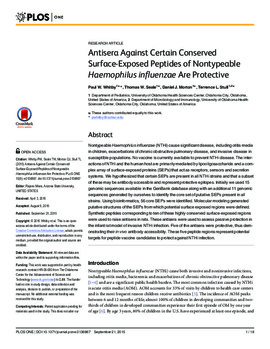| dc.contributor.author | Paul W. Whitby | |
| dc.contributor.author | Thomas W. Seale | |
| dc.contributor.author | Daniel J. Morton | |
| dc.contributor.author | Terrence L. Stull | |
| dc.date.accessioned | 2017-03-05T22:55:08Z | |
| dc.date.available | 2017-03-05T22:55:08Z | |
| dc.date.issued | 2015-09-21 | |
| dc.identifier.citation | Whitby PW, Seale TW, Morton DJ, Stull TL (2015) Antisera Against Certain Conserved Surface-Exposed Peptides of Nontypeable Haemophilus influenzae Are Protective. PLoS ONE 10(9): e0136867. doi:10.1371/journal.pone.0136867 | en_US |
| dc.identifier.uri | https://hdl.handle.net/11244/49268 | |
| dc.description | We thank Timothy VanWagoner for bioinformatics support, Huda Mussa for assistance with sequencing and Brett Cole for assistance with animal studies. We thank Arnold Smith for inspiration and persistence in understanding the basic biology of H. flu..The authors gratefully acknowledge the Children’s Hospital Foundation for promoting the Department of Pediatrics Research Infrastructure. The Foundation provided no financial support for this specific project. | en_US |
| dc.description | | en_US |
| dc.description.abstract | Nontypeable Haemophilus influenzae (NTHi) cause significant disease, including otitis media in children, exacerbations of chronic obstructive pulmonary disease, and invasive disease in susceptible populations. No vaccine is currently available to prevent NTHi disease. The interactions of NTHi and the human host are primarily mediated by lipooligosaccharide and a complex array of surface-exposed proteins (SEPs) that act as receptors, sensors and secretion systems. We hypothesized that certain SEPs are present in all NTHi strains and that a subset of these may be antibody accessible and represent protective epitopes. Initially we used 15 genomic sequences available in the GenBank database along with an additional 11 genomic sequences generated by ourselves to identify the core set of putative SEPs present in all strains. Using bioinformatics, 56 core SEPs were identified. Molecular modeling generated putative structures of the SEPs from which potential surface exposed regions were defined. Synthetic peptides corresponding to ten of these highly conserved surface-exposed regions were used to raise antisera in rats. These antisera were used to assess passive protection in the infant rat model of invasive NTHi infection. Five of the antisera were protective, thus demonstrating their in vivo antibody accessibility. These five peptide regions represent potential targets for peptide vaccine candidates to protect against NTHi infection. | en_US |
| dc.language.iso | en_US | en_US |
| dc.publisher | PLos One | |
| dc.relation.ispartofseries | PLoS ONE 10(9): e0136867 | |
| dc.relation.uri | http://www.plosone.org/article/info%3Adoi%2F10.1371%2Fjournal.pone.0136867 | |
| dc.rights | Attribution 3.0 United States | |
| dc.rights.uri | https://creativecommons.org/licenses/by/3.0/us/ | |
| dc.subject | Outer membrane proteins,Immune serum,Sequence alignment,Bacteremia,Sequence motif analysis,Vaccines,Antibodies,Haemophilus influenzae | en_US |
| dc.title | Antisera Against Certain Conserved Surface-Exposed Peptides of Nontypeable Haemophilus influenzae Are Protective | en_US |
| dc.type | Research Article | en_US |
| dc.description.peerreview | Yes | en_US |
| dc.description.peerreviewnotes | http://www.plosone.org/static/editorial#peer | en_US |
| dc.identifier.doi | 10.1371/journal.pone.0136867 | en_US |
| dc.rights.requestable | false | en_US |

